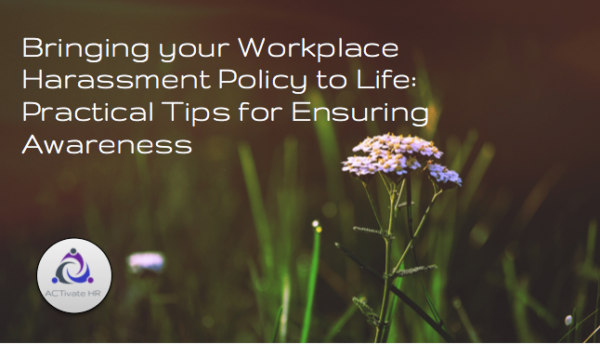You could have the best intentions for implementing your workplace harassment policy. But without effective communication techniques, how will your employees ever understand what’s expected of them?
You’re committed to creating a great culture and providing a safe workplace free from physical and psychological harm. You have leadership commitment. And you’ve integrated harassment into your human resources, corporate, and health and safety policies. You’ve even updated your bullying and harassment policies.
Hang on though…you aren’t quite done yet.
The question is, how are you going to use effective communication techniques to share your policies with employees so they understand their responsibilities?
You want all employees to be aware of the content AND the importance of the policies in a way they’ll remember and be accountable for.
We’re here to help!
On that note, welcome to the third article in our series aimed at helping companies become compliant with Bill 30! As always, we also want to help you successfully create and sustain a psychologically safe and healthy workplace.
As you saw in our first blog in this series, having policies and programs is only the first step. Don’t have your policies updated yet? Be sure to check out our second article, “Are your Policies Up To Par For Preventing Workplace Bullying and Harassment?” as well.
Then, once your policies are updated, you’re ready for the next step – using effective communication techniques to bring your workplace harassment policy to life.
Do you use effective communication techniques?
Your employees knowing a policy exists isn’t enough.
To be effective at proactively preventing bullying and harassment (and addressing any issues that arise), you need to take steps to ensure all leaders and employees:
- Understand what bullying and harassing behaviour looks like
- Know what steps to take if they witness or experience psychological harm in the workplace
- Understand the expectation that they don’t engage in bullying and harassing behaviour
- Understand their role in preventing others from engaging in these behaviours
- Know the outcome if they’re in breach of the policy
Another key point to remember is that creating awareness is an ongoing commitment.
To be effective you must do more than communicate once.
Effective communication techniques should take many forms. They should be integrated into as many mediums and programs as practical. Of course, you’ll want to ensure ongoing commitment to communicating your policies and their contents.
With that in mind, here are some steps to get you started.
Our favorite effective communication techniques
- Communicate the new and/or updated policies and procedures in more than one way. Remember, the more ways employees hear about them, the more likely they are to remember and be aware of their responsibilities.
- Examples of ways to communicate include:
-
- In-person or online training
- Company newsletters
- Townhall meetings
- Safety meetings
- Emails from leadership
- Company intranet
- Coffee pot sessions
- Provide speaking notes to leaders for discussion at team meetings. Hearing about new policies directly from their leader increases the impact and importance of the message.
- Share the company’s goals and objectives for psychological health and safety. Informing employees of what you aim to achieve makes the policies more real than simply letting them know about a new or updated policy.
- Update corporate safety metrics to reference and include psychological safety and injuries. Nothing communicates importance quite like integrating it with company success and personal targets.
- Don’t forget to make sure your human resources team, safety team and health and safety committees are aware of their new responsibilities. At the same time, prepare them for questions they’re likely to receive. Likewise, make sure they know who to refer employees to for questions and issues outside their scope of responsibility.
Following these recommendations helps you bring your new policies and programs to life.
Take care not to let your policy/program roll-out be a bright flash in the pan that disappears quickly. Ongoing commitment to using effective communication techniques will be key to your success in creating a long-burning awareness among employees.
More resources
This article is the third in an 8 part series to help you comply with Bill 30 and move your company forward in creating a psychologically safe and healthy workplace.
To see the previous article in the series about ensuring your policies are solid and comprehensive, click here. In the same vein, take a look at the next blog in this series. It’s full of information on training your employees to be competent in identifying, preventing, and addressing workplace bullying and harassment.
ACTivate HR specializes in customized HR solutions and workplace investigations. Be sure to contact us at info@activatehr.ca if you’d like help using effective communication techniques or have questions on this article or any other of our blogs.
Interested in learning more about our services? Click here.
Follow us on LinkedIn to stay current on our news and articles.
Enjoyed this article? Here are three more to help you:
Acting ‘Reasonably’ in Your Workplace: 5 tips to help you avoid harassment claims
How Procrastination Can Actually Be Your Friend
Effectively Investigating Workplace Bullying and Harassment Hazards and Incidents
This article was originally published on May 28, 2018, and has been updated.

